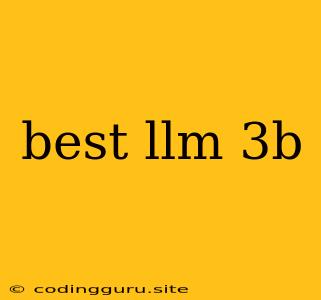Exploring the Frontier of Large Language Models: A Look at the Best 3B Parameter Models
The world of artificial intelligence is constantly evolving, with advancements happening at breakneck speed. One of the most exciting areas of development is the field of Large Language Models (LLMs). These models, trained on vast amounts of text data, are capable of generating human-like text, translating languages, writing different kinds of creative content, and answering your questions in an informative way.
But with so many LLMs popping up, how do you determine which one is the best 3B parameter model for your specific needs? This article will delve into the exciting world of 3B parameter LLMs, providing insights into their strengths, weaknesses, and potential use cases.
What are 3B Parameter LLMs?
Before we dive into specific models, let's understand what 3B parameter LLMs mean. The term "parameter" refers to the number of adjustable values within the model's neural network. A higher parameter count typically indicates a larger and more complex model, capable of learning more intricate patterns from the data.
A 3B parameter model signifies a model with 3 billion parameters. While not the largest in the LLM landscape, these models offer a compelling balance between performance and computational resources. They are powerful enough to tackle complex language tasks but can be deployed on more modest hardware compared to their larger counterparts.
Why Choose a 3B Parameter LLM?
There are several compelling reasons to consider a 3B parameter LLM:
- Performance: These models strike a balance between capability and efficiency. They can perform well on a range of tasks, including text generation, translation, and question answering.
- Resource Efficiency: Compared to larger LLMs, 3B parameter models require less computational power and memory. This makes them more accessible for developers with limited resources.
- Faster Training and Inference: Due to their smaller size, 3B parameter LLMs train and generate output faster than larger models. This is crucial for real-time applications and quick prototyping.
The Best 3B Parameter LLMs: A Look at the Contenders
The world of 3B parameter LLMs is dynamic, with new models constantly emerging. Here are some of the noteworthy contenders:
- GPT-Neo 2.7B: A powerful model from EleutherAI, GPT-Neo 2.7B is known for its strong text generation capabilities. It can generate creative stories, write different types of text, and even provide summaries.
- Bloom 3B: A multilingual model developed by BigScience, Bloom 3B excels in cross-lingual tasks like translation and language understanding. It supports a vast number of languages, making it a valuable tool for global communication.
- MT-NLG 3B: Developed by Google, MT-NLG 3B is known for its ability to generate long-form coherent text. It can be used to write articles, summaries, and even scripts.
Considerations When Choosing Your 3B Parameter LLM
Selecting the right 3B parameter LLM depends on your specific requirements. Consider the following factors:
- Task: What are you trying to achieve with the LLM? Some models are better suited for specific tasks like text generation, translation, or question answering.
- Resource Constraints: How much computational power and memory do you have? 3B parameter models are more efficient than larger models, but they still require resources.
- Fine-tuning: Do you need to fine-tune the model for your specific application? This involves training the model on a custom dataset to improve performance.
- Language Support: If you need to work with multiple languages, consider LLMs that support multilingual tasks.
Conclusion
The world of 3B parameter LLMs is constantly evolving, offering an exciting range of options for developers and researchers. By understanding the key factors and exploring the available models, you can choose the best 3B parameter LLM for your specific needs. Whether it's for generating creative text, translating languages, or answering your questions, these powerful models have the potential to revolutionize how we interact with language and technology.
